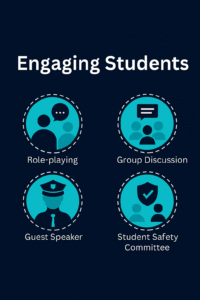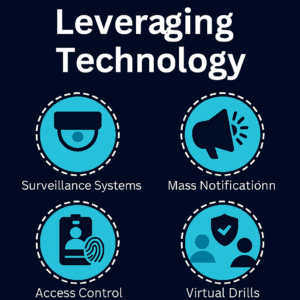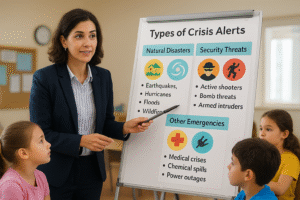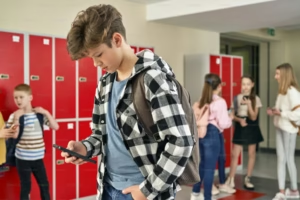Resources

10 Essential Tips for Ensuring Safety in Schools: A Comprehensive Guide for Parents and Educators
Part 2: Advanced Strategies for Preparedness, Support, and Collaboration
In Part 1 of our comprehensive guide, we explored the foundational pillars of school safety—from understanding its importance to implementing key policies, fostering effective communication, and empowering educators as frontline guardians or immediate responders. These elements lay the groundwork for a secure and nurturing learning environment.
Now, in Part 2, we shift focus to the dynamic strategies that bring safety plans to life. From preparing for emergencies to supporting mental health, engaging students directly, and leveraging modern technology, this section dives into the actionable tools that help schools stay responsive and resilient. We also highlight the critical role of collaboration—with law enforcement and community partners—to build a safety ecosystem that extends beyond school walls.
Together, these final five tips offer a roadmap for proactive, inclusive, and tech-enabled safety practices that protect every student and strengthen trust across the entire school community.
Mental Health Support: A Crucial Component of Safety
Mental health support is an integral aspect of ensuring safety in schools, as emotional and psychological well-being directly impacts students’ ability to learn and thrive. Addressing mental health concerns proactively can prevent crises and create a more supportive and nurturing environment. Schools must prioritize mental health by providing resources, education, and support for students, staff, and families.
One effective approach is to integrate mental health education into the school curriculum. This can include teaching students about stress management, emotional regulation, and healthy coping strategies. By normalizing conversations about mental health, schools can reduce stigma and encourage students to seek help when needed. Additionally, schools should provide access to mental health professionals, such as counselors and psychologists, who can offer individual support and intervention for students experiencing difficulties.
Creating a supportive school culture is also essential for promoting mental health. This involves fostering positive relationships between students, teachers, and staff, and encouraging open communication about feelings and concerns. Schools should implement programs and activities that promote social-emotional learning and build resilience. By prioritizing mental health, schools can enhance overall safety and well-being, ensuring that students have the support they need to succeed both academically and personally.
Engaging Students in Safety Awareness Programs
Engaging students in safety awareness programs is a vital strategy for promoting a secure school environment. By involving students in safety initiatives, schools can empower them to take an active role in their own well-being and the well-being of their peers. These programs educate students about potential risks and teach them how to respond appropriately in various situations.
One effective way to engage students is through interactive workshops and activities. These can include role-playing exercises, simulations, and group discussions that help students understand and practice safety protocols. Schools can also invite guest speakers, such as local law enforcement officers or safety experts, to provide valuable insights and real-world perspectives. By making safety education engaging and relevant, schools can capture students’ interest and encourage them to take safety seriously.

Figure 1: Empowering students through role-play, discussion, guest insights, and peer-led initiatives builds a lasting culture of safety
Peer-led initiatives are another powerful tool for promoting safety awareness. Schools can establish student safety committees or clubs that work on safety projects and advocate positive change. These groups can organize events, create educational materials, and lead campaigns to raise awareness about important safety issues. By giving students a voice and a sense of responsibility, schools can foster a culture of safety that extends beyond the classroom.
Leveraging Technology for Enhanced School Security
In today’s digital age, leveraging technology is essential for enhancing school security. Advanced security systems, communication tools, and data management solutions can significantly improve schools’ ability to monitor and respond to potential threats. By integrating technology into safety protocols, schools can create a more efficient and effective security infrastructure.
One of the most impactful technological advancements in school security is the use of surveillance systems. High-definition cameras placed strategically around the school premises can help monitor activities and identify potential risks. These systems can be integrated with access control mechanisms, such as key card entry and biometric scanners, to restrict unauthorized access and ensure that only authorized individuals can enter the school. Additionally, real-time monitoring and alerts can enable school staff to respond quickly to any suspicious activity.
Communication technology also plays a crucial role in enhancing school security. Mass notification systems can quickly disseminate information to all students, staff, and parents in case of an emergency. Mobile apps and online platforms can facilitate instant communication between school administrators, teachers, and parents, ensuring that everyone is informed and can take appropriate action.
Schools can also use technology to conduct virtual safety drills and training sessions, making it easier to reach a larger audience and provide consistent education on safety protocols.
For detailed information on school safety technology, read our blog “How Technology Is Revolutionizing School Emergency Alert Systems for Safer, Faster Crisis Response”.

Figure 2: Technology is transforming school safety—from surveillance and access control to instant alerts and virtual training. These tools help schools respond faster, communicate better, and protect more effectively.
Collaborating With Local Law Enforcement and Community Resources
Collaborating with local law enforcement and community resources is a key strategy for ensuring school safety. Building strong partnerships with these entities can provide schools with valuable support, expertise, and resources to address safety concerns. By working together, schools and their community partners can create a comprehensive and coordinated approach to safety.
One of the primary benefits of collaborating with local law enforcement is the ability to conduct joint training and emergency response exercises. Law enforcement officers can provide schools with insights into best practices for crisis management and help develop and refine emergency response plans.
Regular drills and simulations involving both school staff and law enforcement can ensure that everyone is prepared to respond effectively in case of an emergency. Additionally, having a visible law enforcement presence on campus can act as a deterrent to potential threats.
Community resources, such as mental health organizations, social services, and non-profit groups, can also play a vital role in supporting school safety. These organizations can provide valuable services, such as counseling, crisis intervention, and educational programs, that address the underlying factors contributing to safety concerns. Schools can establish formal partnerships with these organizations to ensure that students and families have access to the support they need. By leveraging the strengths and resources of the broader community, schools can create a more robust and holistic approach to safety.
Conclusion: Building a Safer School Environment Together
Building a safer school environment is a collective effort that requires the collaboration of parents, educators, students, and the broader community. By prioritizing safety and implementing comprehensive measures, schools can create a secure and supportive atmosphere where students can thrive. Each of the ten tips outlined in this two-parts guide plays a crucial role in fostering a culture of safety and preparedness.
Understanding the importance of school safety and implementing key safety policies are foundational steps in creating a secure environment. Effective communication between parents and schools, along with the active involvement of educators, ensures that safety concerns are addressed promptly and effectively. Emergency preparedness, mental health support, and student engagement further enhance the overall safety and well-being of the school community.
Leveraging technology and collaborating with local law enforcement and community resources provide schools with the tools and support needed to address a wide range of safety challenges. By working together and staying proactive, we can build a safer school environment that prioritizes the well-being of every student. Let us commit to making our schools safe havens where children can learn, grow, and achieve their full potential without fear.
Join school leaders, superintendents, and school safety directors for an engaging session on how to embed readiness into your school culture. Register for a free webinar focusing on “Building a Culture of Readiness in School” on 4th November at 2pm Eastern (1pm Central, 11am Pacific) to learn practical strategies to reduce response times, build staff confidence, strengthen community trust and move beyond compliance.
SimulAlert’s Every Second in Mind® approach equips schools to act with confidence—for effective emergency alert and response. Are you exploring safety systems for your school/district? Click here to schedule a SimulAlert® demo.



